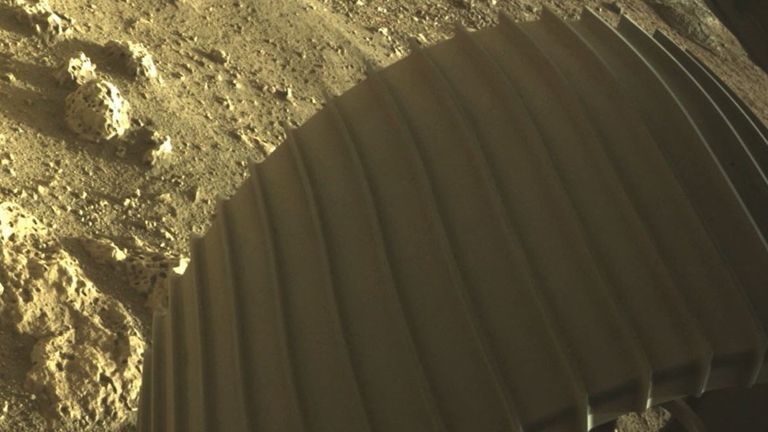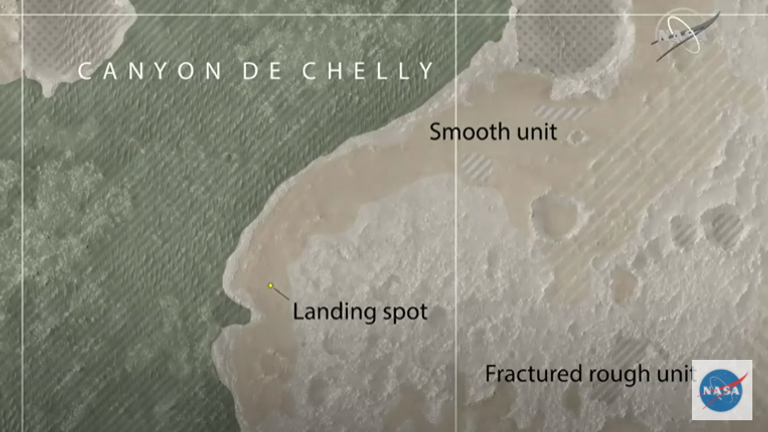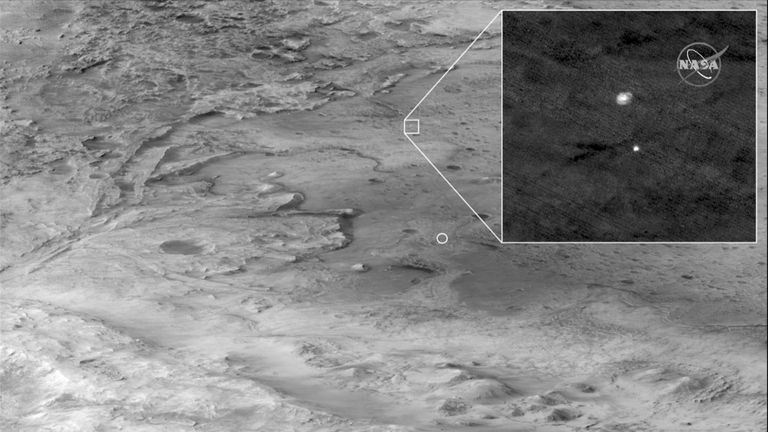Science
Mars landing: Perseverance rover moments before touchdown among new images of Red Planet released by NASA – Sky News

NASA has released new images of the Perseverance rover two metres above the surface of Mars as it gave more details of the mission.
The US space agency’s robot successfully landed on the Red Planet just before 1pm local time on Thursday.
Speaking at a news briefing in California on Friday, NASA officials revealed the rover landed 2km (1.24 miles) from the ancient river delta it was aiming for.
The team also released the three first colour pictures of the landing, which they hope will go down in history with the likes of Neil Armstrong and Buzz Aldrin on the moon.
One picture shows the rover in its final stages of being lowered on to the surface, just two metres off the ground.
A second, taken by the robot’s front hazard camera, captures the probe’s shadow against the surface, while a third offers a view of one of the wheels and rocks close by.
Deputy project scientist Katie Stack Morgan said the rover has already taken more images “than she can count” and more will be made public on Monday.
The area around the landing site has been named the Canyon de Chelly, after the Arizona national park, she added.
Describing the moment NASA first saw the images, she said: “The team went wild. We were in a dream-like state, we couldn’t believe what we were seeing.”
Her colleague, chief engineer Adam Steltzner, added: “It was stunning. The team was awestruck and there was a feeling of victory that we were able to capture these and share them with the world.”
Perseverance had been travelling through space for seven months before it entered the Martian atmosphere yesterday.
It then took just seven minutes to touch down, travelling at 12,100mph – or 16 times the speed of sound – towards the surface.
Listen to the daily podcast on Apple Podcasts, Google Podcasts, Spotify, Spreaker
But ground controllers in Pasadena had another agonising 11 minutes to wait before they received confirmation of the safe landing, with radio signals travelling 33.9 million miles between Mars and Earth at the speed of light.
The rover slowed down as it plummeted closer and closer to the surface, releasing a 70ft parachute and a sky crane to lower itself the final 60ft.
NASA chose to land Perseverance near an ancient river delta and former lake known as the Jezero Crater.
Here it will drill deep down into the sediment of where the river once flowed, collecting material that may hold signs of life.
Although the work has only just begun, NASA managers breathed a sigh of relief yesterday that their $2.7bn (£1.9bn) mission didn’t end in a crash landing.
Science
SpaceX sends 23 Starlink satellites into low-Earth orbit


|
|
April 23 (UPI) — SpaceX launched 23 Starlink satellites into low-Earth orbit Tuesday evening from Space Launch Complex 40 at Cape Canaveral Space Force Station in Florida.
Liftoff occurred at 6:17 EDT with a SpaceX Falcon 9 rocket sending the payload of 23 Starlink satellites into orbit.
The Falcon 9 rocket’s first-stage booster landed on an autonomous drone ship in the Atlantic Ocean after separating from the rocket’s second stage and its payload.
The entire mission was scheduled to take about an hour and 5 minutes to complete from launch to satellite deployment.
The mission was the ninth flight for the first-stage booster that previously completed five Starlink satellite-deployment missions and three other missions.





Science
NASA Celebrates As 1977’s Voyager 1 Phones Home At Last


|
|
Voyager 1 has finally returned usable data to NASA from outside the solar system after five months offline.
Launched in 1977 and now in its 46th year, the probe has been suffering from communication issues since November 14. The same thing also happened in 2022. However, this week, NASA said that engineers were finally able to get usable data about the health and status of its onboard engineering systems.
Slow Work
Fixing Voyager 1 has been slow work. It’s currently over 15 billion miles (24 billion kilometers) from Earth, which means a radio message takes about 22.5 hours to reach it—and the same again to receive an answer.
The problem appears to have been its flight data subsystem, one of one of the spacecraft’s three onboard computers. Its job is to package the science and engineering data before it’s sent to Earth. Since the computer chip that stores its memory and some of its code is broken, engineers had to re-insert that code into a new location.
Next up for engineers at NASA’s Jet Propulsion Laboratory in California is to adjust other parts of the FDS software so Voyager 1 can return to sending science data.
Beyond The ‘Heliopause’
The longest-running and most distant spacecraft in history, Voyager 1, was launched on September 5, 1977, while its twin spacecraft, Voyager 2, was launched a little earlier on August 20, 1977. Voyager 2—now 12 billion miles away and traveling more slowly—continues to operate normally.
Both are now beyond what astronomers call the heliopause—a protective bubble of particles and magnetic fields created by the sun, which is thought to represent the sun’s farthest influence. Voyager 1 got to the heliopause in 2012 and Voyager 2 in 2018.
The Pale Blue Dot is a photograph of Earth taken Feb. 14, 1990, by NASA’s Voyager 1 at a distance of … [+]
NASA/JPL-Caltech
Pale Blue Dot
Since their launch from Cape Canaveral, Florida, aboard Titan-Centaur rockets, Voyager 1 and Voyager 2 have had glittering careers. Both photographed Jupiter and Saturn in 1979 and 1980 before going their separate ways. Voyager 1 could have visited Pluto, but that was sacrificed so scientists could get images of Saturn’s moon, Titan, a maneuver that made it impossible for it to reach any other body in the solar system. Meanwhile, Voyager 2 took slingshots around the planets to also image Uranus in 1986 and Neptune in 1989—the only spacecraft ever to image the two outer planets.
On February 14, 1990, when 3.7 billion miles from Earth, Voyager 1 turned its cameras back towards the sun and took an image that included our planet as “a mote of dust suspended in a sunbeam.” Known as the “Pale Blue Dot,” it’s one of the most famous photos ever taken. It was remastered in 2019.





Science
NASA hears from Voyager 1, the most distant spacecraft from Earth, after months of quiet
|
|
CAPE CANAVERAL, Fla. (AP) – NASA has finally heard back from Voyager 1 again in a way that makes sense.
The most distant spacecraft from Earth stopped sending back understandable data last November. Flight controllers traced the blank communication to a bad computer chip and rearranged the spacecraft’s coding to work around the trouble.
NASA’s Jet Propulsion Laboratory in Southern California declared success after receiving good engineering updates late last week. The team is still working to restore transmission of the science data.
It takes 22 1/2 hours to send a signal to Voyager 1, more than 15 billion miles (24 billion kilometers) away in interstellar space. The signal travel time is double that for a round trip.
Contact was never lost, rather it was like making a phone call where you can’t hear the person on the other end, a JPL spokeswoman said Tuesday.
Launched in 1977 to study Jupiter and Saturn, Voyager 1 has been exploring interstellar space – the space between star systems – since 2012. Its twin, Voyager 2, is 12.6 billion miles (20 billion kilometers) away and still working fine.





-



 Health18 hours ago
Health18 hours agoRemnants of bird flu virus found in pasteurized milk, FDA says
-
Art24 hours ago
Mayor's youth advisory council seeks submissions for art gala – SooToday
-



 Health22 hours ago
Health22 hours agoBird flu virus found in grocery milk as officials say supply still safe
-
Art19 hours ago
Random: We’re In Awe of Metaphor: ReFantazio’s Box Art
-
News15 hours ago
Amid concerns over ‘collateral damage’ Trudeau, Freeland defend capital gains tax change
-



 Investment23 hours ago
Investment23 hours agoTaxes should not wag the tail of the investment dog, but that’s what Trudeau wants
-
News23 hours ago
Peel police chief met Sri Lankan officer a court says ‘participated’ in torture – Global News
-
Media18 hours ago
Vaughn Palmer: B.C. premier gives social media giants another chance








